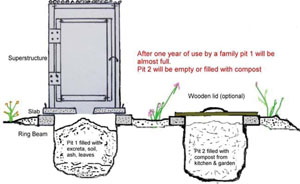20.4.2 Fossa Alterna – a double pit method
The double pit latrine system described in Section 20.2 can be constructed to be an ecosan system. The alternating waterless double pit is also known as Fossa Alterna, which means alternate ditch. The physical structure is constructed in a similar way to a single pit latrine except that it has two pits and they are shallower than a normal pit with a maximum depth of 1.5 m. The slab and superstructure may be movable between the two pits (Figure 20.6) or may be a larger permanent structure that covers both pits.
Like the Arborloo, soil, wood ash, vegetable kitchen waste and leaves are added regularly. A small amount should be added after each defecation (not urination). This introduces necessary plant material to mix with the human waste and also adds a variety of organisms like worms, fungi and bacteria that help in the degradation process.
When the first pit is full, after about 12–24 months depending on the size of the pit and the number of users, everyone starts using the second pit instead. The first pit is covered and the material in it will degrade into a dry, earth-like mixture. This takes about 6–12 months. After this time, the composted mixture is dug out manually and can be used to spread on soil. It is important in the construction to make sure the slab is movable or has a manhole large enough to allow access to the pit for digging out. The health risk for the people who empty the compost is minimal if the pit has been left for over one year. However, good personal hygiene should always be promoted in activities related to sanitation.
20.4.1 Arborloo – a single pit method

